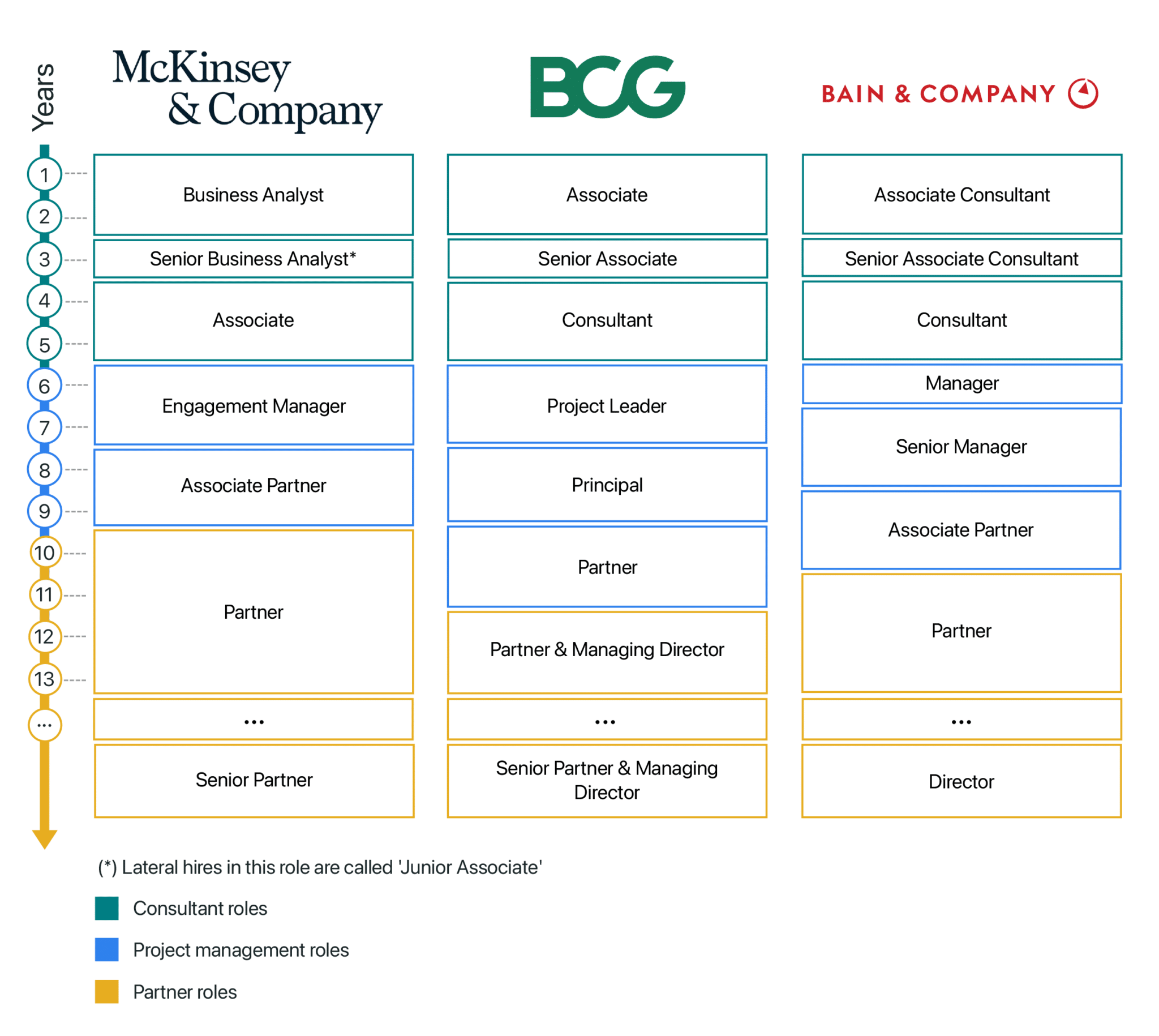McKinsey, BCG and Bain all offer consultants the prospect of rapid career progression along a structured career path, with the opportunity to become a Partner and command a million-dollar salary in just eight to 11 years. In this article, we outline the career path for generalist consultants at McKinsey BCG and Bain, and examine the firms’ approach to managing career progression.
To learn about the career path for consultants in specialized roles, you can read our article on the expert career track at McKinsey, BCG and Bain.
Key takeaways:
- The generalist consulting career path has three key ‘phases’: consultant roles, project management roles and Partner roles.
- Of the worlds’ top-3 consulting firms, McKinsey offers consultants the quickest route to the Partner phase of the consulting career path. The firm offers top-performing consultants the chance to become a Partner in as few as eight years.
- The consulting role is about doing the ‘leg work’ of a project. This includes collecting and analyzing data, interviewing experts and clients, and performing desk research.
- The project management role is about leading projects, managing day-to-day client relationships, coordinating with senior colleagues and managing consultants.
- The Partner role is a position of significant status and responsibility. It’s about being a trusted advisor to clients, generating new business, and being involved in the leadership of a firm.
- McKinsey, BCG and Bain review the performance of consultants every six months against a core set of skills, with expectations rising in line with consultants’ seniority and tenure.
- While career progression at the firms is supported by a number of processes and policies, including an ‘up or out’ policy, the pace of a consultant’s journey along the career path is ultimately determined by their performance.
- Many people choose to conclude their management consulting career after two to four years and pursue one of the many attractive exit opportunities available to former consultants from top-tier firms.
An overview of the management consulting career path
The generalist consulting career path has three key ‘phases’, with roles that evolve over the course of a consultant’s tenure. These phases are:
- Consultant roles
- Project management roles
- Partner roles
McKinsey, BCG and Bain each use different job titles for the various roles in each phase of the consulting career path. In addition, they all offer consultants slightly different routes to Partnership.
The generalist career path at McKinsey, BCG and Bain

McKinsey offers the fastest career path to Partner
As the graphic above shows, all three firms offer the prospect of rapid career progression and the opportunity to reach the level of Partner in a relatively short period of time.
Those who complete every level of the consulting career path at McKinsey can become a Partner after just nine years. At Bain, consultants typically reach this position after 10 years.
At BCG, the job title of ‘Partner’ is, in fact, part of the project management phase of the firm’s consulting career path. BCG consultants usually progress to the position in the firm that commands Partner-level compensation – Partner and Managing Director – after 11 years.
However, in all three firms, top performers are able to bypass the second level of the consulting career path and consequently reach the level of Partner a year early. McKinsey therefore offers consultants the fastest route to becoming a Partner, with the potential to achieve this in just eight years.
Roles and responsibilities on the generalist management consulting career path
Consultant roles
Consultants work as part of project teams to help clients in large organizations solve their more complex and challenging problems. Consultants do all the ‘leg work’ of the project, such as:
- collecting and analyzing data
- interviewing experts and clients
- performing desk research
- identifying insights and proposing recommendations
- creating slide presentations
- contributing to problem solving-discussions
- working alongside client team members
How the consultant role evolves
At McKinsey, BCG and Bain, the consultant phase of the career path is divided into three different roles. While the job itself is essentially the same, as consultants progress through each role they are expected to work increasingly independently. They’re also required to handle more complex or important pieces of the project, and spend more time managing client relationships.
At McKinsey and BCG, these roles don’t usually include managerial responsibilities. However, at Bain, consultants in the most senior position within this phase play a role in managing more junior members of the team.
Candidates who are fresh out of university or have less than two years’ professional experience typically join McKinsey, BCG or Bain in an entry-level position. Compensation for consultants at this level is $120-£125K. As consultants progress along the career path, their compensation increases steadily in line with their responsibilities and the firms’ expectations of their performance.
Consultants typically stay in this initial role for around two years, after which some move on to either the second or third role of the consultant phase, depending on their performance. Others go to business school, sponsored by the firm.
Those who join a top-3 firm with an advanced degree or with two to five years of professional experience typically begin their careers in the second role of the consulting phase. This gives them higher compensation than new graduates, and a quicker route to reaching the top levels of their firm. These consultants typically stay in the role for two years in order to have more time to learn the ropes of the profession.
Entry-level consultants, meanwhile, typically stay in this role for just one year before moving on to the third role of the consultant’s career path.
Those who join McKinsey, BCG or Bain after completing an MBA typically begin their careers in the third role of the consultant phase. Some experienced professional hires with at least five years’ experience – and, in the US, some advanced degree hires – can also join at this level. This provides candidates with a faster route to the project management phase of the consulting career path, and a total starting compensation of $220-225K.
Project management roles
The project management phase of the consulting career path is all about taking the reins on a client project. This involves managing day-to-day client relationships and coordinating with senior stakeholders within the firm, including Partners. It also involves managing the consultants who work on the project, and generally ensuring a successful result.
How the project management role evolves
At McKinsey, BCG and Bain, the project management phase is divided into two or three roles, all of which are challenging. As the initial role in this phase marks a consultant’s first experience of owning the delivery of a whole project, it’s often considered to be a ‘make or break’ moment in a management consulting career.
While the job is essentially the same for all the roles in this phase, consultants will be entrusted with bigger teams and more complex projects as they progress. Their work will also start to coalesce on a specialism – typically in a specific industry or function – and recurring clients. While consultants in this phase are initially dedicated to one project, in the final role they will start splitting their time between several projects and supporting less experienced managers.
It is very rare for individuals to join a top consulting firm in a project management role. On the generalist career track, most suitable candidates will be working at a similar or more senior level at ‘the Big-4’ or another tier-2 consulting firm.
Compensation increases further in this phase of the consulting career path, with total annual earnings of $395-405K available in the most senior project management role.
Partner roles
In top consulting firms, Partners function as strategic advisors to clients. They are primarily responsible for generating new business, managing and developing client relationships, and ensuring that the firm delivers positive results for clients. Partners also play a leadership role within their firm, sometimes leading an office, a function (e.g. recruiting, social events), or a practice area.
For some, being elected to the position of Partner at McKinsey, BCG or Bain represents the ultimate career goal. The position comes with significant status and responsibility, along with an average starting compensation of close to $1,000,000.
It’s very rare for individuals to join a top consulting firm as a Partner. This is only a possibility for those who are already Partners at a comparable firm or – in exceptional circumstances – C-level executives with outstanding industry experience.
After a few more years, some Partners are promoted by their peers to a senior partnership position within their firm, which comes with multi-million dollar annual compensation. This is the very top echelon of the consulting career path.
How career progression works at McKinsey, BCG and Bain
At McKinsey, BCG and Bain, performance reviews typically take place every six months. From new hires to Senior Partners, consultants are all evaluated on a set of core skills. The performance expectations for each skill rise in line with the consultant’s role and tenure.
Feedback is gathered from individuals who have worked with the consultant in the previous six months. A committee of Partners then assigns the consultant to a particular performance bracket (e.g. ‘underperforming’, ‘as expected’, ‘exceeding expectations’).
When consultants meet the performance criteria of the next level in the consulting career path they are promoted. The firms impose no limit on how many people can be promoted at the end of a performance review cycle.
When a consultant is assigned to the lowest performance bracket, the committee of Partners reviews the evidence again. If the majority deem there to be no chance of the situation improving, the consultant is asked to leave under the firm’s ‘up or out’ policy.
The promotion timeline itself can vary among firms and local offices; some enforce a minimum or maximum amount of time at each level, while others can be more flexible.
While these processes and policies are in place to support career progression at McKinsey, BCG and Bain, the pace of a consultant’s journey along the consulting career path will ultimately be determined by their performance.
Moving on from a career in management consulting
Although the profession offers an attractive career path, with regular promotion cycles and increasingly generous compensation, many people choose to leave management consulting after two to four years. A variety of attractive exit opportunities – many of which are at a senior executive level – are available to former consultants from top-tier firms because of the abundance of highly transferable skills they develop during their time in consulting.
If a management consulting career sounds like it might be right for you, you can learn more in our complete guide to the industry. And if you’re preparing to apply to a top consulting firm, the resume and cover letter templates and specialized advice in our Free Resume Course will help you get your application in great shape.







